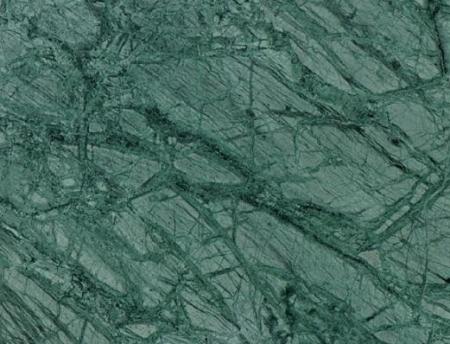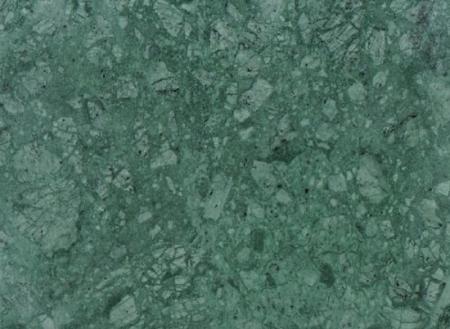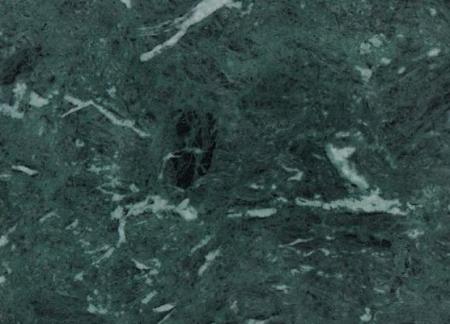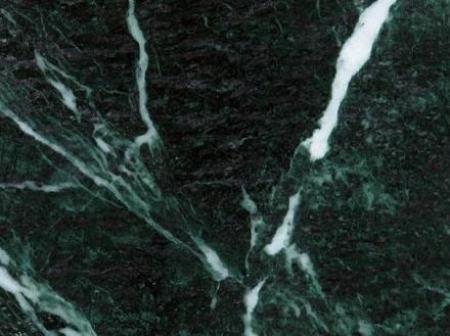Apart from the well known deposits of granite in India, the country also has the biggest deposits of Green Marble (sometimes known as Verde Guatemala in the international markets). Its technical definition would be recrystallised, compact variety of metamorphosed limestone capable of taking polish, rock composed of Serpentine. The Indian green is a very compact and mature marble and is strong. Its hardness / strength is greater in comparison to other green stones found elsewhere. For example, Indian marble does not warp. Unlike some others, it does not fade in colour over time and neither does it oxidize. Architecturally and aesthetically speaking, it has a soothing green tone, for example, an entire flooring in green marble looks great. Moreover, it provides an excellent contrast when installed in combination with different other colours of marble.
Green marble quarries
The green marble deposits are located in the mineral rich Aravali mountain range. The exact location is in the districts of Udaipur and Dungarpur, in the south -west part of the state of Rajasthan. The deposits are spread over a vast area in both the districts consisting of many villages, out of which Kesariyajee region in Udaipur district and the adjoining areas of Dungarpur district are prominent. These deposits were discovered in late 70s and early 80s. The mineral deposit is huge & the area is mainly of hills and mountains.
There are a large number of quarries working in the region. The concessions for quarries are granted by the government for mining on lease basis which normally lasts for 20 years. The lease is then usually renewed upon expiry. There are almost 300 quarry leases in the region of green marble.
Extraction
The excavation of green marble from the quarries is done in a totally mechanised manner nowadays with state of the art machinery such as chain saws, wire saws, boring machines etc. used extensively for quarrying. Heavy earth moving machinery is also used in the quarries thereby easing the problem of over burden and handling of marble blocks. Thanks to the above technology, the production capacity of green marble has risen phenomenally. Production in 2011 was estimated to be around 150,000 metric tons. The blocks extracted from the quarries are of big size and, therefore, big size slabs are available without any problems.
Varieties of Green Marble
The green marble available in the region comes in various tones and the tonality differs slightly from one region to another. Basically it can be divided into two types:
1) one being dark plain green with flower structure
2) the other having a green base with white veins.
Tone and texture differs from place to place adding to the different varieties. Of the first type, the shade can vary from light to dark, and these shades have been given different names such as Forest Green, Jade Green, Ocean Green, Oasis Green, etc. The second type is similar to the above and the veins and clouds can also vary, such as being scattered, or clubbed together, or having thin veins, thick veins, etc.


Forest Green refers to the medium to dark variety with the same varieties of veins. Jade Green is the name given for the variety with more consistency. Ocean Green refers to the dark variety with white veins and there are several other commercial names for this. Oasis Green is the name for consistent medium green with white ripples.


Processing facilities
There are modern processing facilities in India to make slabs / tiles / monuments of marble and they are equipped with state of the art machinery from around the world. The darker version of green marble tends to have cracks and is thus mostly commercialised in the form of tiles. Many companies have the facilities for producing both slabs and tiles under one roof. The machines include gang saws, automatic line polishers for slabs, bridge cutting machine, fully automated tiling plants and automatic epoxy lines. Installed capacity would be of around 150 modern gangsaw units. The Udaipur based companies mostly work with green marble located in South Rajasthan while the Jaipur based companies mostly deal with what is known as Rain Forest Green, the quarries of which are located in Bidaser, about 250 km from Jaipur, in north east Rajasthan.
Finishes
The most common finish is the polished one, but the honed finish also has demand. In recent times the leather finish has also become popular.
Markets and applications
The Indian green marble is being exported to more than 75 countries around the globe. Almost 90 % of the exports are in the form of finished products as tiles and slabs. It is mainly shipped from the seaports of Mundra and Kandla. A container with marble reaches Europe in about 20 days, America in about 35 days and the Far East in 8-15 days.
As with many other stones, there have been ups and downs in the demand for the material in keeping with changes in fashion and trends. Price fluctuation too has been a feature of this material as a result of varying demand. Overall, the demand for Indian green marble remains widespread all over the world as well as in India, it fits with all tastes and applications. It has been used in palaces, luxury showrooms, offices of corporate houses, hotels, mosques, etc. A decade ago most of the green marble was exported, but now the domestic market has now become extremely important for the green marble producers. It is one of those few materials that have found its own niche in the market, a material that is here to stay.
Note: Our thanks to Kalit Bhandari, Hitesh Patel, Narpat Singh Shekhawat, Prabhat Jain, Ishwnder Singh, Jagdish Prasad Khetan, and Narendra Sharma for the information provided.
